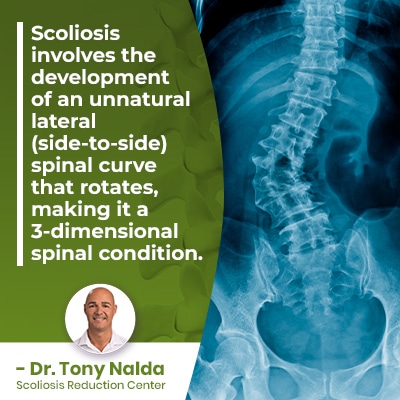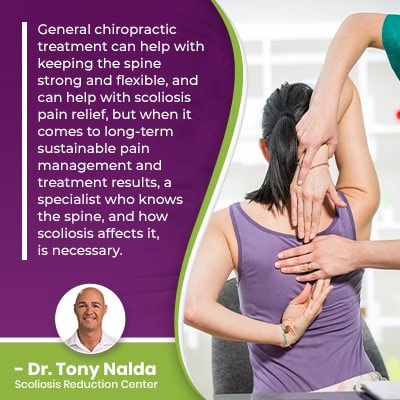Can Chiropractors Help Scoliosis? Yes! Here's Our Results:

While the complex nature of scoliosis is beyond the scope of general chiropractic, scoliosis-specific chiropractic care, when combined with other proactive treatment disciplines, can work towards correcting scoliosis on a structural level for the best potential results.
Surgery was once the dominant scoliosis treatment option, but we've since learned enough about the condition, and treatment-efficacy, to know that not all cases of scoliosis require surgery. Condition-specific chiropractic care can achieve corrective results without the risks associated with surgery.
As scoliosis is so often deemed a complex condition to treat, let's start with why.
Table of Contents
Diagnosing Scoliosis
Reaching a scoliosis diagnosis isn't always a simple process.
 Scoliosis involves the development of an unnatural lateral (side-to-side) spinal curve that rotates, making it a 3-dimensional spinal condition.
Scoliosis involves the development of an unnatural lateral (side-to-side) spinal curve that rotates, making it a 3-dimensional spinal condition.
In addition, in order to be diagnosed as scoliosis, the abnormal curvature also has to be of a minimum size: Cobb angle measurement of at least 10 degrees.
A patient's Cobb angle is determined during X-ray by drawing lines from the tops and bottoms of the curve's most-tilted vertebrae, at its apex, and the resulting angle is expressed in degrees.
Cobb angle is known as the gold standard in the assessment and diagnosis of scoliosis, and it shapes the design of treatment plans.
When the spine's healthy curves are in place, this means its vertebrae (bones) are aligned and stacked on top of one another as they are designed to be, but when an unnatural spinal curve develops, some of those vertebrae are tilted unnaturally, causing a misaligned spine.
A patient's Cobb angle tells me how far out of alignment a scoliotic spine is, in addition to classifying conditions in terms of severity:
- Mild scoliosis: Cobb angle measurement of between 10 and 25 degrees
- Moderate scoliosis: Cobb angle measurement of between 25 and 40 degrees
- Severe scoliosis: Cobb angle measurement of 40+ degrees
- Very-severe scoliosis: Cobb angle measurement of 80+ degrees
The fact that scoliosis is a 3-dimensional spinal condition that varies so widely in severity is part of the reason it can be so complex to treat; in addition, scoliosis is also progressive.
Scoliosis is a Progressive Condition
As a progressive condition, scoliosis has it in its nature to worsen over time, so where a scoliosis is at the time of diagnosis doesn't mean that's where it will stay, at least not without the help of a proactive treatment plan.
Scoliosis can easily progress from mild to moderate, severe, and very severe if left untreated, and because its nature is to do so.
Counteracting progression is a big focus of treatment, and while we don't always fully understand what triggers the initial onset of scoliosis, we do know what triggers its progression: growth and development.
So treating children with scoliosis means monitoring for progression and having the goal of reducing the curvature and holding it there, despite the constant progressive trigger of growth.
In adults, progression tends to slow down, at least until natural age-related spinal degeneration comes into effect, and scoliosis can affect all ages, which is why a specialist is needed to recognize the subtle differences in modifying treatment plans to address the needs of different age groups.
There is congenital scoliosis that babies are born with, infantile scoliosis that develops between 6 months and 3 years old, early-onset juvenile scoliosis that affects children between the ages of 3 and 10, adolescent idiopathic scoliosis, and adult scoliosis patients who have reached skeletal maturity.
There are also different types of scoliosis that can develop, each with its own unique cause, symptoms, and treatment needs.
The Main Types of Scoliosis
The most common type of scoliosis overall is idiopathic scoliosis, and the idiopathic designation means not clearly associated with a single-known cause.
Adolescent idiopathic scoliosis (AIS), diagnosed between the ages of 10 and 18, is the most prevalent form overall, and idiopathic scoliosis accounts for approximately 80 percent of known diagnosed cases, while the remaining 20 percent are associated with known causes: neuromuscular scoliosis, degenerative scoliosis, and congenital scoliosis.
Another reason scoliosis requires a specialist to treat the condition effectively is because there are multiple types, with different treatment needs.
Cases of idiopathic scoliosis are considered typical, while cases with known causes are considered atypical and are more complex to treat; for example, in neuromuscular scoliosis patients, there is an underlying neuromuscular condition, such as muscular dystrophy, cerebral palsy, or spina bifida.
When a larger neuromuscular condition has caused scoliosis to develop as a secondary complication, it's the underlying neuromuscular condition that has to be the guiding force of treatment, which makes it more challenging to treat scoliosis.
In typical cases of scoliosis, the scoliotic curve bends to the right, away from the heart, but in atypical cases, it bends to the left, towards the heart, and when I see this, as a scoliosis specialist, I know this is a red flag that there is an underlying pathology at play.
General Chiropractic Treatment vs Scoliosis-Specific Chiropractic Treatment
So can chiropractors fix scoliosis: yes, they can, but only if the chosen chiropractor is a scoliosis-chiropractor, and only if the chiropractic care is combined with other important treatment disciplines.
 General chiropractic treatment can help with keeping the spine strong and flexible, and can help with scoliosis pain relief, but when it comes to long-term sustainable pain management and treatment results, a specialist who knows the spine, and how scoliosis affects it, is necessary.
General chiropractic treatment can help with keeping the spine strong and flexible, and can help with scoliosis pain relief, but when it comes to long-term sustainable pain management and treatment results, a specialist who knows the spine, and how scoliosis affects it, is necessary.
As a CLEAR Scoliosis Institute chiropractor, I'm trained and certified in multiple condition-specific treatment disciplines so I can fully customize treatment plans to address key patient/condition variables, and impact the condition on every level.
Being proactive with treatment can mean helping patients avoid surgery that's invasive, costly, and comes with some serious potential risks (spinal fusion).
Here at the Scoliosis Reduction Center, I offer patients a conservative treatment approach that integrates condition-specific chiropractic care, physical therapy, corrective bracing, and rehabilitation into treatment plans.
Through scoliosis-specific chiropractic care, I can work towards adjusting the position of the curve's most-tilted vertebrae back into alignment with the rest of the spine, and this restores as much of the spine's healthy curves as possible.
Realigning the spine also means that there is less pressure on the spine's surrounding muscles and nerves.
Physical therapy uses condition-specific exercises and stretches to improve posture and increase core strength so the spine is optimally supported by its surrounding muscles.
Corrective bracing is known to be particularly effective on growing spines and can help augment corrective results achieved through other treatment disciplines by pushing the spine into a corrective position and holding it there.
The last phase of treatment is about holding those results, and as an incurable progressive condition, scoliosis can't be cured in the traditional sense; continued work needs to be done to sustain results into the future.
A series of custom-prescribed exercises can help patients establish a home-rehabilitation program to further stabilize and heal the spine for long-term sustainable treatment results.
Conclusion
While there are a number of spinal conditions a person can develop that involves a loss of its natural and healthy curves, the complex nature of scoliosis necessitates a customized treatment approach, and a scoliosis chiropractor can help.
No two patients will experience their scoliosis in exactly the same way, so it makes sense that no two patients would require the exact same type of scoliosis care.
While general chiropractic can help with increasing spinal flexibility for short-term pain relief, in order to achieve corrective results, a scoliosis chiropractor is needed to fix scoliosis.
Correcting scoliosis means a curvature reduction has been achieved on a structural level, and as a structural spinal condition, it has to be, first and foremost, impacted on a structural level.
Scoliosis chiropractors have a number of manipulative and rehabilitative therapy techniques they can use to address areas of vertebral subluxation, restore as much of the healthy spinal curvatures as possible, and improve the spine's overall strength, function, and health.
When condition-specific chiropractic care is integrated into a proactive treatment plan, there are fewer limits to what can be achieved; when it comes to treating progressive conditions, one of the most important factors is when treatment is started, and the best time to start treatment is always now.
Scoliosis only gets more complex to treat as it progresses: the scoliosis curvature gets larger, more rigid, less responsive to treatment, and related muscle imbalances can also occur.
While there are never treatment guarantees, early detection and intervention does increase the likelihood of treatment success.
Dr. Tony Nalda
DOCTOR OF CHIROPRACTIC
After receiving an undergraduate degree in psychology and his Doctorate of Chiropractic from Life University, Dr. Nalda settled in Celebration, Florida and proceeded to build one of Central Florida’s most successful chiropractic clinics.
His experience with patients suffering from scoliosis, and the confusion and frustration they faced, led him to seek a specialty in scoliosis care. In 2006 he completed his Intensive Care Certification from CLEAR Institute, a leading scoliosis educational and certification center.
About Dr. Tony Nalda
 Ready to explore scoliosis treatment? Contact Us Now
Ready to explore scoliosis treatment? Contact Us Now





